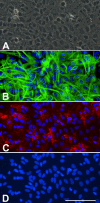Microglial cells in astroglial cultures: a cautionary note
- PMID: 17937799
- PMCID: PMC2140055
- DOI: 10.1186/1742-2094-4-26
Microglial cells in astroglial cultures: a cautionary note
Abstract
Primary rodent astroglial-enriched cultures are the most popular model to study astroglial biology in vitro. From the original methods described in the 1970's a great number of minor modifications have been incorporated into these protocols by different laboratories. These protocols result in cultures in which the astrocyte is the predominant cell type, but astrocytes are never 100% of cells in these preparations. The aim of this review is to bring attention to the presence of microglia in astroglial cultures because, in my opinion, the proportion of and the role that microglial cells play in astroglial cultures are often underestimated. The main problem with ignoring microglia in these cultures is that relatively minor amounts of microglia can be responsible for effects observed on cultures in which the astrocyte is the most abundant cell type. If the relative contributions of astrocytes and microglia are not properly assessed an observed effect can be erroneously attributed to the astrocytes. In order to illustrate this point the case of NO production in activated astroglial-enriched cultures is examined. Lipopolysaccharide (LPS) induces nitric oxide (NO) production in astroglial-enriched cultures and this effect is very often attributed to astrocytes. However, a careful review of the published data suggests that LPS-induced NO production in rodent astroglial-enriched cultures is likely to be mainly microglial in origin. This review considers cell culture protocol factors that can affect the proportion of microglial cells in astroglial cultures, strategies to minimize the proportion of microglia in these cultures, and specific markers that allow the determination of such microglial proportions.
Figures



Similar articles
-
Astrocytes enhance lipopolysaccharide-induced nitric oxide production by microglial cells.Eur J Neurosci. 2002 Oct;16(7):1275-83. doi: 10.1046/j.1460-9568.2002.02199.x. Eur J Neurosci. 2002. PMID: 12405988
-
Microglial and astroglial reactions to inflammatory lesions of experimental autoimmune encephalomyelitis in the rat central nervous system.J Neuroimmunol. 1992 Mar;37(1-2):23-33. doi: 10.1016/0165-5728(92)90152-b. J Neuroimmunol. 1992. PMID: 1372328
-
Primary culture of cortical neurons, type-1 astrocytes, and microglial cells from cynomolgus monkey (Macaca fascicularis) fetuses.J Neurosci Methods. 2003 Dec 30;131(1-2):133-40. doi: 10.1016/j.jneumeth.2003.08.006. J Neurosci Methods. 2003. PMID: 14659833
-
Plasticity of astrocytes in primary cultures: an experimental tool and a reason for methodological caution.Dev Neurosci. 1985;7(5-6):263-77. doi: 10.1159/000112295. Dev Neurosci. 1985. PMID: 3915290 Review.
-
Bioengineered 3D Glial Cell Culture Systems and Applications for Neurodegeneration and Neuroinflammation.SLAS Discov. 2017 Jun;22(5):583-601. doi: 10.1177/2472555217691450. Epub 2017 Feb 21. SLAS Discov. 2017. PMID: 28346104 Review.
Cited by
-
A distinct brain pathway links viral RNA exposure to sickness behavior.Sci Rep. 2016 Jul 20;6:29885. doi: 10.1038/srep29885. Sci Rep. 2016. PMID: 27435819 Free PMC article.
-
Role of astroglial toll-like receptors (TLRs) in central nervous system infections, injury and neurodegenerative diseases.Brain Behav Immun. 2021 Jan;91:740-755. doi: 10.1016/j.bbi.2020.10.007. Epub 2020 Oct 8. Brain Behav Immun. 2021. PMID: 33039660 Free PMC article. Review.
-
Abnormal Cannabidiol Affects Production of Pro-Inflammatory Mediators and Astrocyte Wound Closure in Primary Astrocytic-Microglial Cocultures.Molecules. 2020 Jan 23;25(3):496. doi: 10.3390/molecules25030496. Molecules. 2020. PMID: 31979350 Free PMC article.
-
Microglial regulation of immunological and neuroprotective functions of astroglia.Glia. 2015 Jan;63(1):118-31. doi: 10.1002/glia.22738. Epub 2014 Aug 13. Glia. 2015. PMID: 25130274 Free PMC article.
-
Picomolar concentrations of oligomeric alpha-synuclein sensitizes TLR4 to play an initiating role in Parkinson's disease pathogenesis.Acta Neuropathol. 2019 Jan;137(1):103-120. doi: 10.1007/s00401-018-1907-y. Epub 2018 Sep 17. Acta Neuropathol. 2019. PMID: 30225556 Free PMC article.

